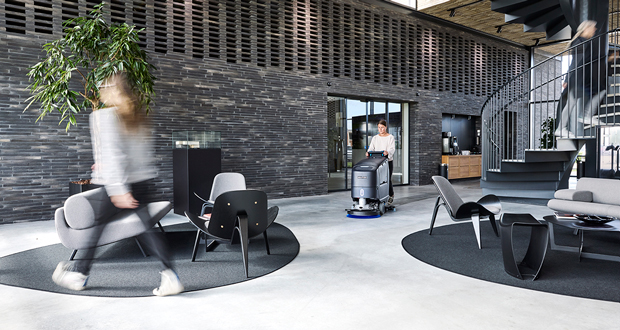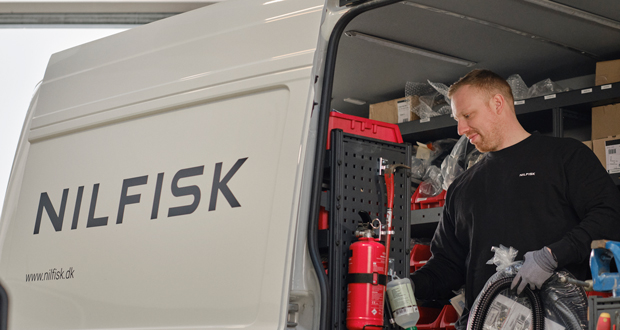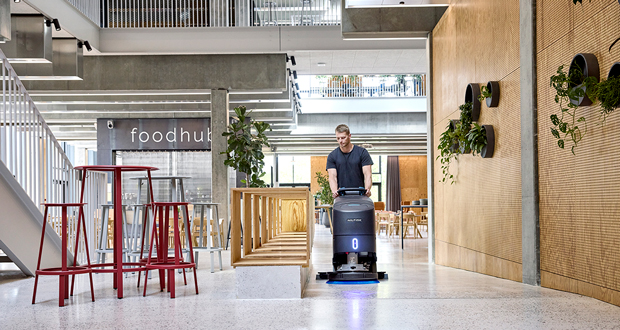It’s no secret that routine maintenance is essential to maximise cleaning equipment performance. Yet, with many cleaning staff facing high workloads, daily maintenance habits can sometimes fall by the wayside.
As the sector continues to battle productivity challenges, rising employee and material costs, alongside increasing sustainability pressures, ensuring maintenance best practice to reduce cleaning machine downtime and extend operating lifespans has never been more important.
Ian Buckle, Head of Brand & Design at Nilfisk, highlights the role that a fresh design approach has to play in delivering tailored and intuitive cleaning machine solutions that address the sector’s ongoing maintenance challenges.
Making maintenance a priority
When we think about our cars, or the boilers that heat our homes, the need for preventative servicing and ongoing maintenance to avoid costly repairs and maximise performance is well recognised.
The same is true for cleaning machinery, which often undertakes repeatable cleaning cycles in tough operating environments. In fact, according to research by IBM, strategic and proactive maintenance of machines, such as cleaning equipment, can reduce downtime by up to 50 per cent, increase productivity by 20-50 per cent, reduce breakdowns by 70-75 per cent and cut maintenance costs by 5-10 per cent.
Cleaning businesses often make significant investments in a variety of cleaning equipment solutions. As such, they need assurance that its performance is continually maximised for the long-term.
Effective maintance strategies hold the key to this. But time-poor, fatigued cleaning staff and complicated maintenance processes mean daily routines can sometimes be neglected or delayed.
And the unwanted consequences of this can be significant – from reduced efficiencies, unwanted repair bills and shortened machine lifespans, to the potential reputational damage linked to sub-standard cleaning.

Designed to succeed
The simple answer to making routine and proactive maintenance tasks an embedded, recognised and effective part of cleaning operations, lies in the creation of machines that turn traditional design strategies on their head.
To do that, a fresh approach to cleaning machine design is needed. That is one that puts people at its core and delivers intuitive, flexible, easy-to-maintain and ergonomically adaptable cleaning machines.
This delivers numerous benefits. It supports a better user experience, lessens the physical and mental strain of machine operation, underpins practical operational efficiencies and supports improved sustainability ambitions.
When looking at how this can solve the sector’s maintenance and productivity challenge, new machinery designs should incorporate functional features to simplify machine operation and maintenance for users. This could include:
- An operator’s interface tailored to the user’s language – ensuring instructions or maintenance notifications are easily understood and can be actioned quickly.
- Colour-highlighted user touch points – so operators can see easily where attach/detach functions lie for removing cleaning decks or filling up cleaning solutions, for example.
- Adaptable interfaces that represent the user’s skill level – for example, limiting the functionality offered to less experienced users to avoid confusion and ensure essential notifications aren’t missed.
- Time-saving features – such as a water filling indicator, so operators can keep topped up to maximise clean quality, without having to repeatedly stop to check and refill.
- Easy-to-remove attachments, such as squeegees – ensuring these are quick and easy to attach, detach, clean and store.
- On-machine training, delivered via a unique user interface – so users can check any operating questions simply, without delays to cleaning tasks.
Each of these functional developments are designed to simplify the operation and essential maintenance of cleaning machines, ensuring daily tasks to optimise performance are quick, undemanding and inclusive.

A best practice approach
There are also a handful of practical measures cleaning operations can adopt to tackle the long-standing maintenance challenge, without putting additional pressures on cleaning operators. These will support and not disrupt day-to-day cleaning operations, helping to maximise high quality cleaning and enhance cost-efficiency and productivity.
- Collaborate with your workforce – while easy maintenance routines will optimise cleaning machinery performance, how the machines are operated can also have an impact on extending their lifespan. Working with cleaning staff to share the importance of user behaviour is critical. This involves educating them on why routine maintenance is important and sharing how simple this process can be.
- Automate for better outcomes – look for machine solutions that can be pre-calibrated to automate material use, speed and machine power for individual jobs. This can help to alleviate the common tendency to select maximum settings, which can put unnecessary stress on the machine. It will also optimise resource use, reduce waste and improve sustainability.
- Get proactive – ensure cleaning equipment has the functionality to proactively notify operators when maintenance tasks are required. This keeps routine maintenance on schedule and supports long-term planning around essential machine availability.
It’s well recognised that committing to regular maintenance routines will prolong cleaning machine lifespans and reduce unwanted cleaning machine downtime by up to 50 per cent.
Innovative cleaning machine design changes are making things simpler, providing cleaning businesses with welcome access to improved productivity and efficiency, without adding extra pressure to the cleaning operator’s individual responsibilities.

To find out more, visit Nilfisk’s website: https://www.nilfisk.com/global/professional/campaigns/sc550/





